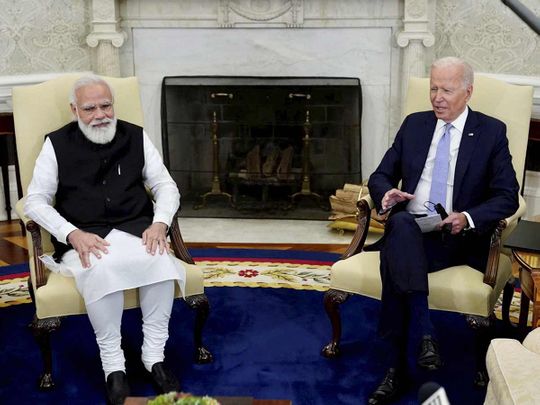
Indo-US relations are poised for an unprecedented breakout. The opportunities are virtually immense, with very limited downsides. It is this message that is being broadcast loud and clear, especially from the American side. During an ongoing visit to the United States, such repeated signalling, not only in private conversations with key influencers but also from speakers in important conferences, is impossible to miss.
There is an extraordinary effort from the US side, orchestrated on many fronts, to drive home the idea that India should grab this unprecedented opening to take the relationship to a new level of mutual trust and cooperation. Given the beginning of a new Cold War, the US needs India, more than ever, on its side.
What is keeping India back, is the question that the Americans are asking. Is it hesitation or lack of clarity, lingering mistrust or deliberate delay to leverage more advantages?
In important conferences and events in the Bay Area, the strategic partnership between the US and India is being couched in terms of techno-cooperation.
“A New Agenda for Indian Competitiveness,” a one-day meeting at Stanford University’s Shorenstein Asia-Pacific Research Center (APARC), emphasised how the US, with its advanced technology and private investment, can contribute critically to India’s national security.
High level government officials on both sides underscored the need to open the closely guarded defence sector in India to US capital and high-tech.
The advantages accruing to the make-in-India campaign, in addition to upgrading defence preparedness, would be immense.
US-India special bond
Of the 18 speakers, many on the US side were Indian Americans. They were unanimous in asserting that India should not let go of this special break, occasioned by the war in Ukraine, and the US’ earlier decoupling from China. India, they believed, should move beyond the legacy of non-alignment or older Indo-Russian friendship obligations to a more open and affirmative Indo-US partnership.
The East-West divide today is neither geographical nor economic, runs such an argument. With Japan and Korea in Asia very much a part of the Western alliance, it was India’s turn to step up to the high table. Harping on India’s own "two centuries of humiliation" does not serve India’s interests though it buys crucial manoeuvrability.
Following closely after the APARC conference is the United States India Strategic Partnership Forum’s West Coast Summit at Menlo Park on May 9. With speakers ranging from Condoleezza Rice, former US Secretary of State, Taranjit Sandhu, India’s curent Ambassador to the United States, Indian American Congressman, Ro Khanna, and a host of Silicon Valley executives, the conference stresses how much both sides can benefit from the ongoing partnership between the two countries.
With a hundred unicorns of over $333 billion in net value, India’s growth story needs US high tech, expertise, and capital, much of which are now in the hands of Indian American entrepreneurs.
Sandwiched between these two conferences, was The IndUS Entrepreneurs (TIE) Silicon Valley Conference 2022, May 5-7, at the Santa Clara Convention Centre. The TiECon networking platform was founded by Kanwal Rekhi, Suhas Patil, and Prabhu Goel in 1992. Over the three decades of its existence, it has spread to 60 chapters in 17 countries, raising billions of dollars for tech start-ups all over the world.
Imagination Unleashed!
This year’s theme, “Imagination Unleashed!” focused on technologies of the future, including AI and Web 3.0. Though not overtly political or strategic in its orientation, TiECon Silicon Valley 2022 also underscored the tremendous value of Indo-US high-tech partnership for India’s exponential growth in the decades to come.
Clearly, India, with it’s over 1.4 billion people and multiple challenges, definitely needs technology and capital from the US. Both of these are heavily concentrated in the Silicon Valley.
When we shift our attention to Europe, United Kingdom’s Brexit and the European Union’s inability to hold up the lofty ideal of European peace and prosperity even as it celebrates Europe Day on May 9 only remind us of how uncertain and destabilising the situation is.
If Russia wanted a swift and successful intervention in Ukraine, with minimum loss of lives and materials, that objective seems to have been frustrated. Clearly, India’s over-reliance on Russian arms will prove a liability in the future.
The Ukraine conflict is also Germany’s Zeitenwende (“turning point”). Taking greater responsibility for Europe’s safety, the chief antagonist in last century’s two world wars is now rearming itself.
Emmanuel Macron’s second term is also an assertion of France’s commitment to nobler civic virtues rather than narrower identity politics. Yet, the European Union’s huge bureaucracy makes its quick rise to unified intervention and hyperpower status unlikely.
What should India’s stand be? Is it times to take sides boldly or hold out? No easy answer is possible at this juncture even though US keenness to secure India’s commitment is obvious. India’s economic interests lie clearly in strengthening its prosperity partnership with America. Its large and influential diaspora also make India and US natural allies. Without question, the time has come to take Indo-US relations to new heights.
But India’s geostrategic imperatives also require a careful balancing of other relationships, not only with Russia, but also with China.
How skilfully India navigates its future course will determine its rise as a global power. In a multi- even hetero-polar world, India’s options should not be limited to putting all its eggs in one basket.










